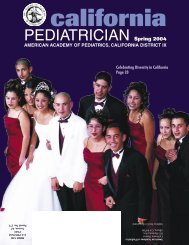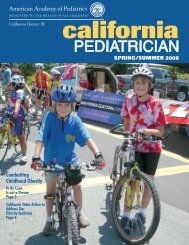PEDIATRICIAN Spring 2003 - AAP-CA
PEDIATRICIAN Spring 2003 - AAP-CA
PEDIATRICIAN Spring 2003 - AAP-CA
Create successful ePaper yourself
Turn your PDF publications into a flip-book with our unique Google optimized e-Paper software.
Weighing the Radiation Risks of CT Scans<br />
Nikta Forghani, M.D., Ronald A. Cohen, M.D., and Myles B. Abbott, M.D.<br />
Computed tomographic (CT) scanning<br />
is a valuable imaging modality<br />
on which pediatricians increasingly<br />
rely. However, pediatricians may not realize<br />
that CT scans expose children to high amounts<br />
of ionizing radiation that may have detrimental<br />
long-term consequences. Recent data from<br />
studies of survivors exposed to low-dose radiation<br />
from the atomic bombs in Hiroshima and<br />
Nagasaki 1 , and the increased risk of leukemia<br />
in children who have two or more radiologic<br />
procedures 2 , suggest that pediatricians should<br />
be more circumspect when ordering CT scans.<br />
More than two million CT scans are done<br />
on children each year in the United States. 3 The<br />
use of CT imaging in both adults and children<br />
has increased by 700% over the past ten years 3 ,<br />
although it has been estimated that 40% of CT<br />
scans performed on children are unnecessary. 4<br />
This increase is in large part due to the fact that<br />
CT imaging has been more widely recognized<br />
as a superior imaging modality for many clinical<br />
problems. While CT imaging has enormous<br />
diagnostic benefit, its widespread use is a<br />
source of potential harm, especially to pediatric<br />
patients. The National Research Council’s<br />
Factors and Procedures<br />
Yearly exposure at sea level 3<br />
Living in Denver (high altitude) 6<br />
Transcontinental flight 0.25<br />
Committee on the Biological Effects of Ionizing<br />
Radiation on Children has determined<br />
that children under 10 years of age are several<br />
times more sensitive to ionizing radiation than<br />
middle-aged adults. 5 In addition, since children<br />
have a longer life span, their potential longterm<br />
risk of radiation damage is increased.<br />
Furthermore, some of the new advances in<br />
CT technology make the scans faster and<br />
more accurate (and therefore more appealing<br />
in the context of pediatric radiology), but may<br />
come with a price of higher ionizing radiation<br />
exposure.<br />
To appreciate the amount of radiation<br />
in a CT scan, it may be helpful to compare<br />
CT radiation with both a standard chest X-<br />
ray and the background radiation to which<br />
we are all exposed in the environment. The<br />
exposure from an abdominal CT scan is 5 to<br />
10 millisieverts (mSv) 1 , which is 250 to 500<br />
times greater radiation than a standard chest<br />
radiograph (which is .02 mSv). The amount of<br />
background radiation varies in different locations,<br />
but the average background radiation in<br />
the United States (excluding medical sources)<br />
is about 3 mSv per year. The table shows the<br />
Table: Representative Values of Effective Radiation Doses Associated with<br />
Various Environmental Factors and Medical Procedures 7, 8<br />
Chest X-ray 0.02 – 0.05<br />
Skull X-ray<br />
Abdominal X-ray<br />
Intravenous pyelogram<br />
Upper gastrointestinal series<br />
Barium Enema<br />
Head CT<br />
Chest CT<br />
Abdominal CT<br />
Ultrasonography 0<br />
Magnetic Resonance Imaging 0<br />
Effective dose in mSv<br />
0.1– 0.2<br />
0.5 – 1.5<br />
2.5 – 5.0<br />
3.0<br />
3.0 – 7.0<br />
2.0 – 4.0<br />
5.0 – 15.0<br />
5.0 – 15.0<br />
approximate amount of radiation associated<br />
with various environmental factors, medical<br />
procedures involving ionizing radiation, and<br />
medical procedures that do not expose patients<br />
to radiation.<br />
Much of the current concern about the<br />
effects of ionizing radiation on children stems<br />
from recently published research about cancer<br />
risk in atomic bomb survivors. Today, more<br />
than 50 years after their initial exposure,<br />
individuals have been identified who received<br />
radiation doses that are similar to doses<br />
achieved with modern CT scans (8-30 mSv).<br />
The research shows that these individuals have<br />
a small but statistically significant increased<br />
mortality risk from cancer.<br />
Pediatricians and pediatric radiologists<br />
ought to work collaboratively to determine the<br />
best imaging technique for each patient. When<br />
non-radiation modalities (ultrasonography or<br />
MRI) are as diagnostic as CT for the child’s<br />
condition, they should be preferred. However,<br />
CT scans are often the most appropriate imaging<br />
modality. When CT is used, there are ways<br />
to reduce the exposure to radiation:<br />
• Reduce CT settings, which can be<br />
done without significantly compromising<br />
image quality. In one recent trial, ionizing<br />
radiation exposure in children was reduced by<br />
75% while quality was maintained. 6<br />
• Utilize more focused or limited CT<br />
scans to minimize the extent of radiation exposure.<br />
For example, when trying to identify a<br />
hepatic abnormality, CT can focus on the liver<br />
rather than the entire abdomen and pelvis.<br />
• Perform only the minimum number<br />
of CT scans necessary for the diagnosis. There<br />
are very few circumstances when multiple CT<br />
scans are necessary.<br />
• Be judicious in repeating CT scans<br />
to follow a pathologic process. Consider other<br />
imaging modalities to follow the process.<br />
REFERENCES:<br />
1. Pierce DA, Preston DL. Radiation-related<br />
cancer risks at low doses among atomic<br />
bomb survivors. Radiation Research. 2000;<br />
154:178-186.<br />
2. Infante-Rivard C, Mathonnet G, Sinnett D.<br />
Risk of childhood leukemia associated with<br />
CONTINUED ON PAGE 28<br />
<strong>CA</strong>LIFORNIA <strong>PEDIATRICIAN</strong> — SPRING <strong>2003</strong>/ 7








